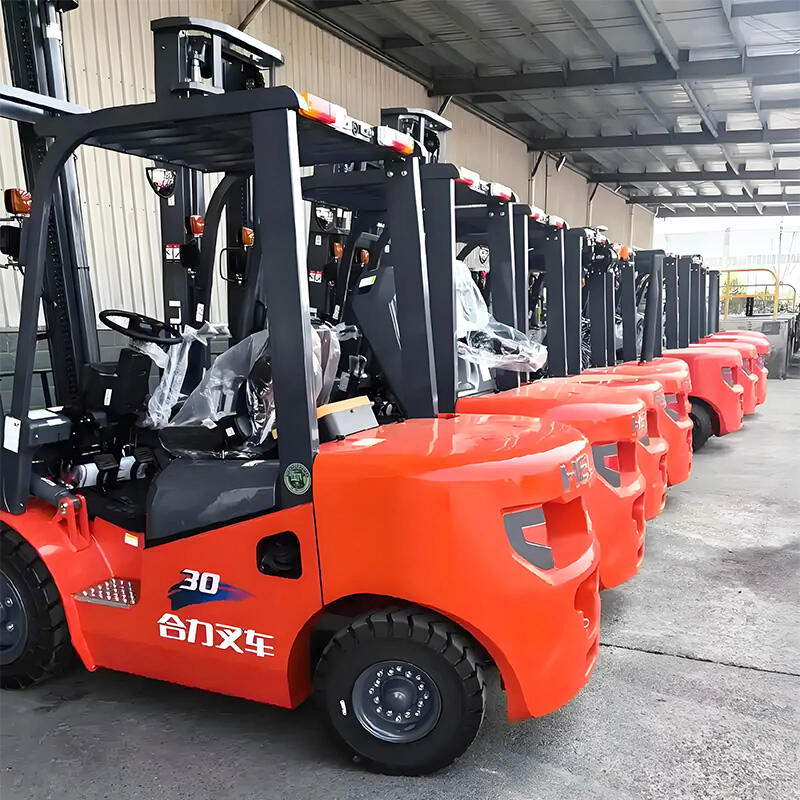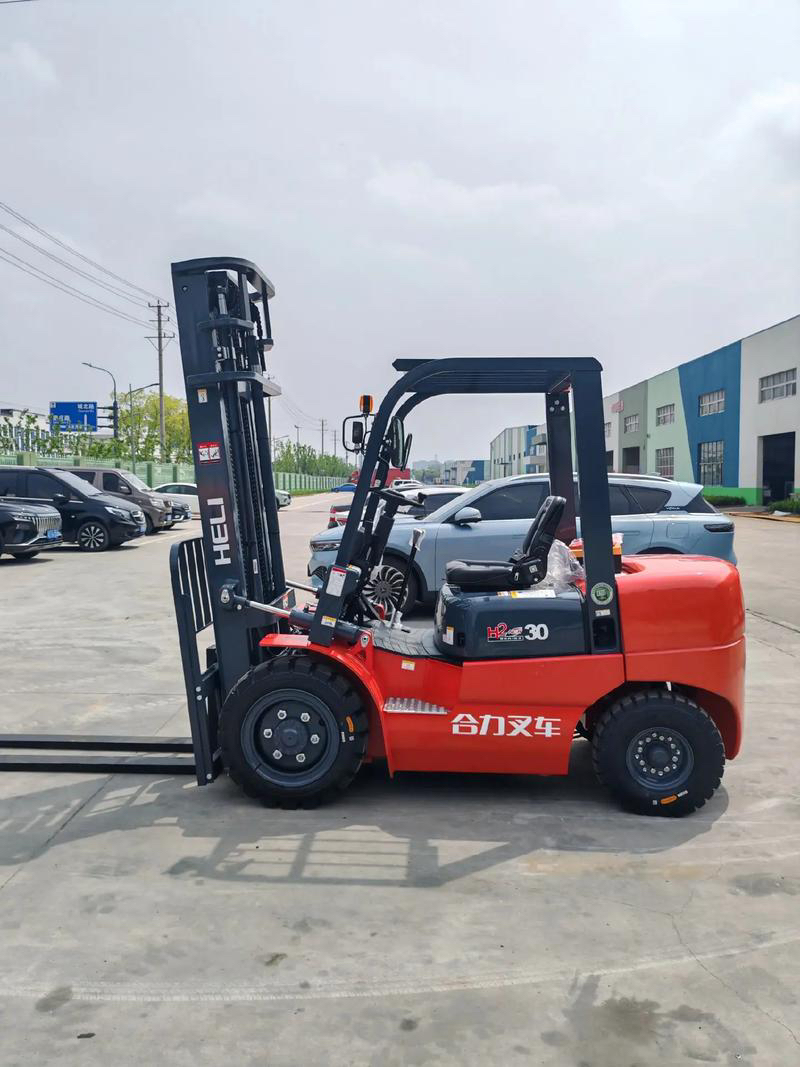Empilhadeiras são veículos de movimentação industrial usados para carregar, descarregar, empilhar e transportar mercadorias paletizadas em curtas distâncias. Elas são chamadas de caminhões industriais pela Organização Internacional para Padronização (ISO/TC110). Elas são comumente usadas para transportar itens grandes em armazéns e geralmente são movidas por motores a combustível ou baterias. Os parâmetros técnicos de uma empilhadeira são usados para indicar suas características estruturais e desempenho operacional. Os principais parâmetros técnicos incluem: capacidade de elevação nominal, distância do centro de carga, altura máxima de elevação, ângulo de inclinação do mastro, velocidade máxima de deslocamento, raio de giro mínimo, distância mínima do solo e distância do eixo e distância entre eixos, entre outros.
Selecionar a empilhadeira apropriada para suas necessidades específicas é crucial para maximizar a eficiência, garantir a segurança e minimizar os custos operacionais. Uma empilhadeira mal escolhida pode levar à diminuição da produtividade, aumento das despesas de manutenção e até mesmo acidentes no local de trabalho. Este guia fornece uma visão geral abrangente dos fatores a serem considerados ao tomar esta importante decisão.
Atualmente, o método de classificação predominante para empilhadeiras na indústria é dividi-las em categorias I-V, a saber: empilhadeiras elétricas de contrapeso (Classe I), empilhadeiras elétricas de armazenamento acionadas por passageiros (Classe II), empilhadeiras elétricas de armazenamento ambulantes (Classe III), empilhadeiras de contrapeso de combustão interna de rodas sólidas (Classe IV) e empilhadeiras de contrapeso de combustão interna de rodas infláveis (Classe V).

Antes mesmo de começar a navegar pelos modelos de empilhadeiras, você deve avaliar cuidadosamente seus requisitos operacionais. Isso envolve várias considerações importantes:
Requisitos de manuseio de materiais: Quais tipos de materiais você estará manuseando? O peso, tamanho e formato de suas cargas influenciam diretamente a capacidade e configuração da empilhadeira. Você estará movendo paletes, tambores, materiais longos ou algo totalmente diferente? Considere a fragilidade da carga e a necessidade de acessórios especiais.
Ambiente de trabalho: Onde a empilhadeira irá operar? O ambiente impacta significativamente o tipo de empilhadeira mais adequado para o trabalho. Aplicações internas geralmente favorecem empilhadeiras elétricas devido à sua operação limpa e poluição sonora reduzida. Ambientes externos, particularmente aqueles envolvendo terrenos acidentados, podem exigir empilhadeiras com motor de combustão interna (ICE) robustas e potentes. Considere fatores como condições do piso (liso, irregular, inclinado), restrições de espaço (corredores estreitos, raios de giro apertados) e condições climáticas (temperaturas extremas, umidade).
Frequência e intensidade de uso: com que frequência a empilhadeira estará em operação? Ela será usada por algumas horas por dia ou continuamente em vários turnos? Aplicações de alta intensidade exigem empilhadeiras duráveis e confiáveis, projetadas para uso prolongado. O uso menos frequente pode justificar um modelo mais econômico.
Capacidade de carga e altura de elevação: determine o peso máximo que sua empilhadeira precisa levantar e a altura de elevação necessária. Essas especificações são cruciais para garantir uma operação segura e eficiente. Sobrecarregar uma empilhadeira é extremamente perigoso e pode levar à falha do equipamento e ferimentos. A avaliação precisa desses parâmetros não é negociável.
Espaço Operacional: Analise o layout de suas instalações. Considere as larguras dos corredores, áreas de giro e a proximidade de obstáculos. Empilhadeiras compactas são ideais para espaços confinados, enquanto modelos maiores são necessários para manusear cargas mais pesadas ou operar em áreas abertas.
2. Tipos de Empilhadeiras:
Existem vários tipos de empilhadeiras disponíveis, cada uma com características e aplicações únicas:
Empilhadeiras Contrabalanceadas: O tipo mais comum, essas empilhadeiras usam contrapesos para equilibrar a carga. Elas são versáteis e adequadas para várias aplicações, disponíveis em versões elétricas e ICE.
Empilhadeiras com condutor sentado: o operador fica sentado enquanto opera a empilhadeira, proporcionando maior conforto e controle para uso prolongado.
Empilhadeiras com operador em pé: o operador fica em pé durante a operação, oferecendo melhor visibilidade em espaços confinados.
Empilhadeiras retráteis: projetadas para corredores estreitos, as empilhadeiras retráteis estendem seus garfos para acessar paletes, maximizando a utilização do espaço de armazenamento.
Selecionadores de pedidos: usados para atendimento de pedidos em armazéns, os selecionadores de pedidos permitem que os operadores selecionem itens de vários níveis.
Empilhadeiras: usadas principalmente para empilhar e recuperar paletes em ambientes com pouco espaço livre.
Empilhadeiras para terrenos irregulares: projetadas para terrenos irregulares, essas empilhadeiras robustas são ideais para aplicações externas ou canteiros de obras.

A escolha do combustível impacta significativamente os custos operacionais, o impacto ambiental e os requisitos de manutenção:
Empilhadeiras elétricas: oferecem operação limpa e silenciosa, manutenção reduzida e custos de operação mais baixos. No entanto, elas têm tempos de operação limitados antes de exigir recarga.
Empilhadeiras a GLP (Gás Liquefeito de Petróleo): Oferecem um bom equilíbrio entre desempenho, custo e impacto ambiental.
Empilhadeiras a gasolina: oferecem desempenho potente, mas produzem emissões e exigem manutenção mais frequente.
Empilhadeiras a diesel: a opção mais potente, mas também a menos ecológica e a mais cara de manter.
Recursos de segurança: priorize empilhadeiras com recursos de segurança robustos, como sistemas de detecção de carga, paradas de emergência e estruturas de proteção do operador (ROPS).
Requisitos de manutenção: considere as necessidades de manutenção da empilhadeira e a disponibilidade de serviços e peças.
Ergonomia: Escolha uma empilhadeira com controles confortáveis e design ergonômico para minimizar a fadiga do operador e melhorar a produtividade.
Opções de financiamento: explore opções de leasing ou compra para encontrar a solução mais econômica para o seu negócio.
Dada a complexidade da seleção de empilhadeiras, é altamente recomendável consultar um revendedor ou empresa de aluguel de empilhadeiras de boa reputação. Eles podem fornecer consultoria especializada com base em suas necessidades operacionais específicas e ajudá-lo a escolher a empilhadeira mais adequada para seu negócio. Não hesite em fazer perguntas e comparar completamente os diferentes modelos antes de tomar sua decisão final. Uma escolha bem informada contribuirá significativamente para a segurança, eficiência e lucratividade de suas operações.

6. Após selecionar o tipo apropriado de empilhadeira, seu desempenho precisa ser avaliado a partir dos seguintes aspectos:
capacidade de carga: o peso máximo que a empilhadeira pode suportar com segurança. Altura de elevação: a altura máxima que uma empilhadeira pode levantar mercadorias. Comprimento do garfo: o comprimento do garfo determina o tamanho da carga que pode ser transportada. Desempenho de potência: os indicadores de potência, torque e velocidade do motor afetam diretamente a eficiência de manuseio e a capacidade de subida da empilhadeira. Desempenho de direção: o raio de direção e a flexibilidade afetam a capacidade da empilhadeira de operar em espaços estreitos. Confiabilidade e durabilidade: a qualidade, o design e o processo de fabricação dos componentes da empilhadeira afetam diretamente a vida útil e a confiabilidade das empilhadeiras. Você pode julgar verificando a marca, o modelo, o fabricante e o serviço pós-venda da empilhadeira. Segurança: as empilhadeiras são equipadas com dispositivos de segurança, como cintos de segurança, luzes de advertência, limitadores de velocidade, etc. Respeito ao meio ambiente: se os padrões de emissão estão em conformidade com os regulamentos nacionais ou regionais relevantes.
Direitos autorais © 2024 por Shanghai Weide Engineering Machinery Equipment Co, Ltd. | Política de Privacidade